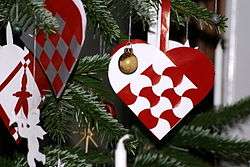Pleated Christmas hearts
Pleated Christmas hearts (Danish: Julehjerte) are Danish, Norwegian, and north German crafts, commonly used as Christmas ornaments.[1]

History
The exact age and origin of the tradition of making paper hearts is unknown, but the oldest known pleated Christmas hearts were made by the Danish author Hans Christian Andersen in 1860. However, as Andersen's heart has no handle, it seems unlikely it could have been used as a Christmas tree ornament. That pleated heart is today located in the Hans Christian Andersen Museum in the city of Odense in Denmark. It is documented, however, that Andersen did make decorations for Christmas trees, and that the predecessors of the pleated Christmas hearts were made from wicker baskets.
The oldest known guide to making pleated Christmas hearts is found in the Official Nordic handicraft Journal (1871),, and the oldest pleated Christmas heart (from 1873) is preserved at the National Museum of Denmark, in Copenhagen. But it was still some 40 years before the pleated Christmas hearts became more widespread.
It is believed that kindergartens from around 1910 started spreading the use of the pleated Christmas hearts, which were made from glossy paper in order to enhance the children's creative abilities, patience, and fine motor skills.
Pleated books
- The first pleated Christmas book, Julehjerter (1975), was released by the Lottrup Knudsen brothers.
- A more recent book (2002) which includes a big variety of pleated Christmas heart templates, is Francis Jordt's Flettede julehjerter(https://bibliotek.kk.dk/ting/object/870970-basis%3A24272486)
References
- "Hjerter og glaskugler til jul from history-online.dk". Historie-online.dk (in Danish). Retrieved July 30, 2009.